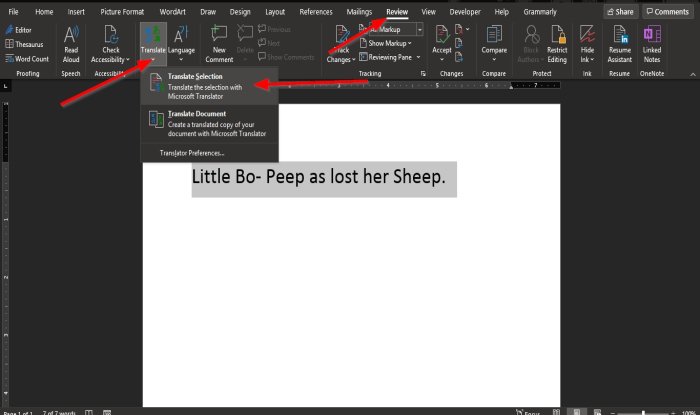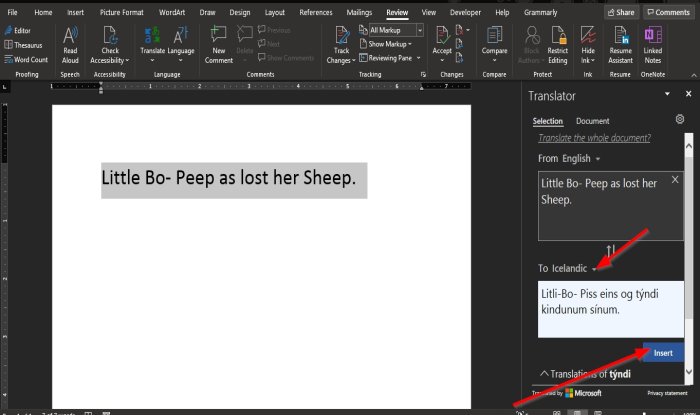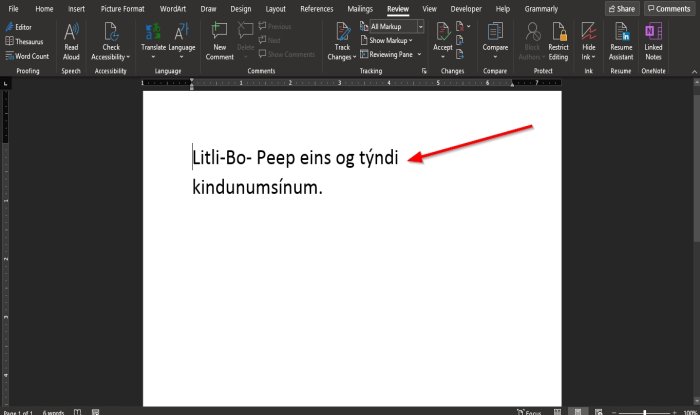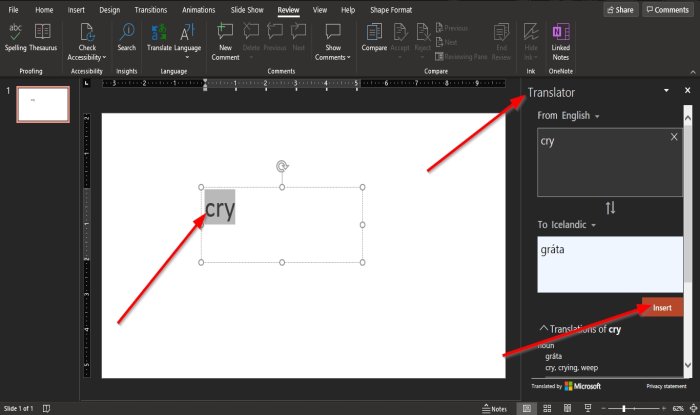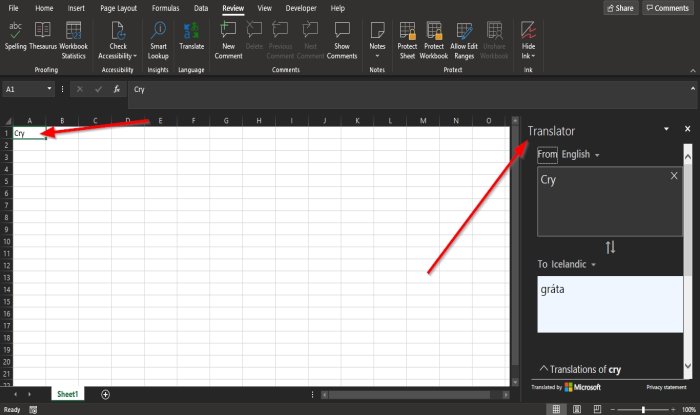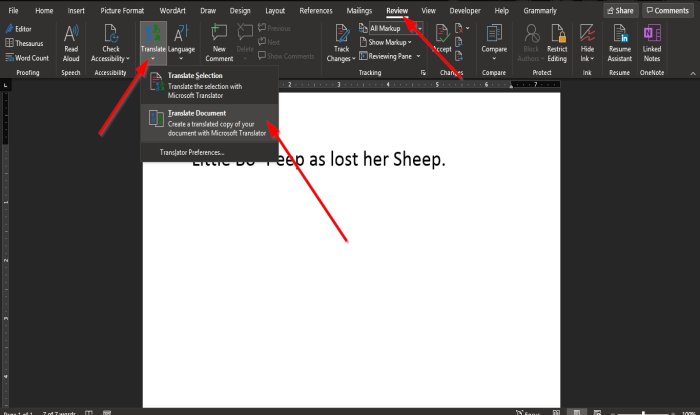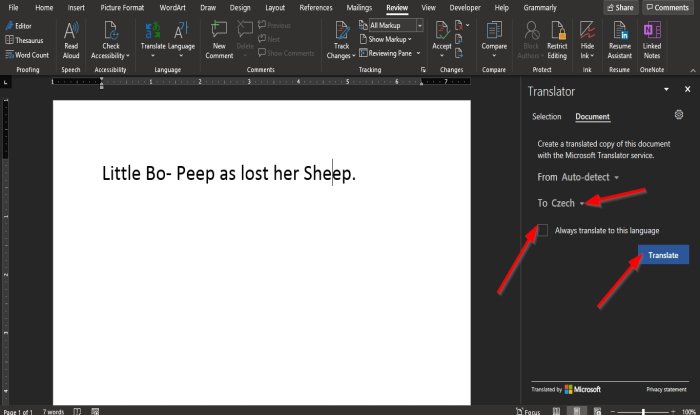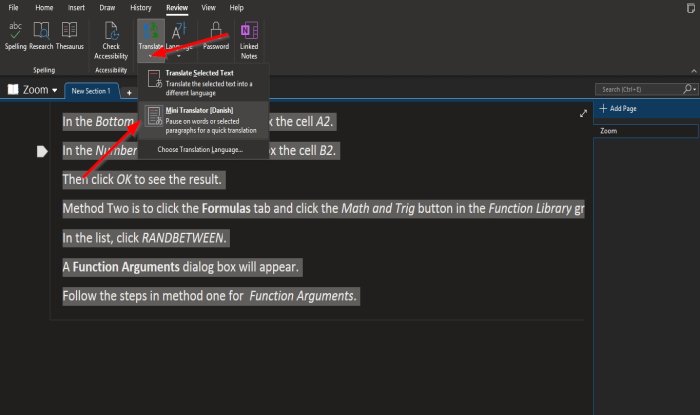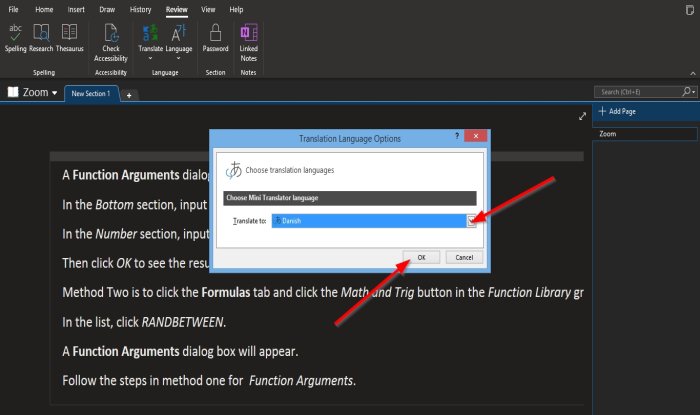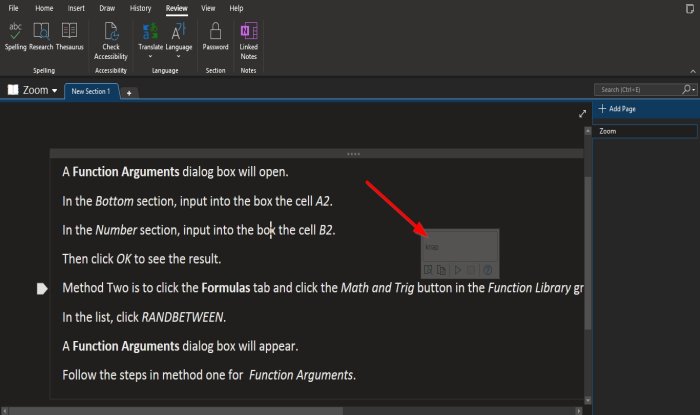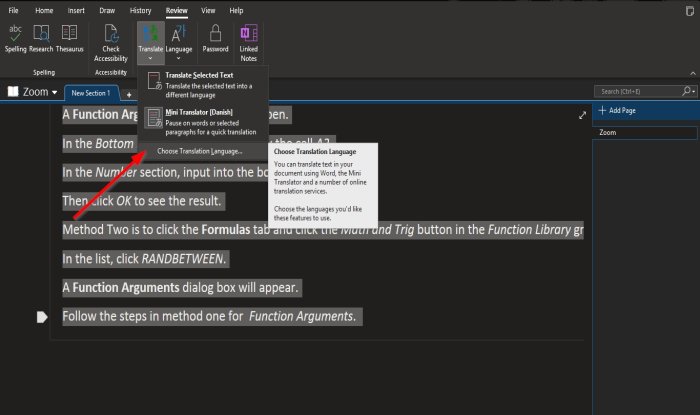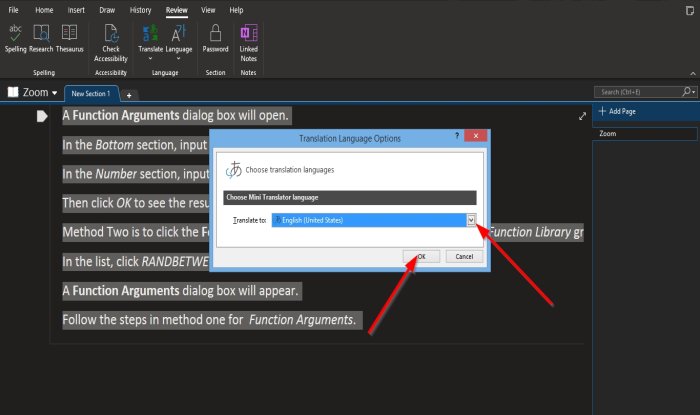Excel for Microsoft 365 Word for Microsoft 365 PowerPoint for Microsoft 365 OneNote for Microsoft 365 Publisher for Microsoft 365 Visio Plan 2 Excel for Microsoft 365 for Mac Word for Microsoft 365 for Mac PowerPoint for Microsoft 365 for Mac Word for the web Excel 2021 Word 2021 PowerPoint 2021 Publisher 2021 Visio Professional 2021 Visio Standard 2021 OneNote 2021 Excel 2021 for Mac Word 2021 for Mac PowerPoint 2021 for Mac Excel 2019 Word 2019 PowerPoint 2019 Publisher 2019 Visio Professional 2019 Visio Standard 2019 Excel 2019 for Mac Word 2019 for Mac PowerPoint 2019 for Mac Excel 2016 Word 2016 Outlook 2016 PowerPoint 2016 OneNote 2016 Publisher 2016 Visio Professional 2016 Visio Standard 2016 Excel 2013 Word 2013 Outlook 2013 PowerPoint 2013 OneNote 2013 Publisher 2013 Visio Professional 2013 Visio 2013 Outlook.com Excel 2010 Word 2010 Outlook 2010 PowerPoint 2010 OneNote 2010 Publisher 2010 Visio 2010 Visio Standard 2010 New Outlook for Windows More…Less
The Translate feature is currently available for Word, Excel, OneNote, Outlook, and PowerPoint.
Note: The procedures for Outlook for the web are the same as the procedures for the new Outlook for Windows. Select the Web tab above for those instructions.
Translate an email in Outlook
In Outlook, you can translate words, phrases, and full messages when you need them. You can also set Outlook to automatically translate messages you receive in other languages.
When you receive an email in another language, you’ll see a prompt at the top of the message asking if you’d like Outlook to translate it into your preferred language.
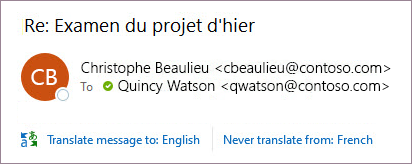
When you receive an email in another language, you can respond in two different ways:
-
In the message, select Translate message. Outlook replaces the message text with translated text.
After you’ve translated the message, you can select Show original to see the message in the original language or Turn on automatic translation to always translate messages to your preferred language.
-
In the message, select Never translate. Outlook won’t ask you if you’d like to translate messages in the future.
If, for some reason, Outlook doesn’t offer these options, select the Translate button from the ribbon, or right-click on the message and select Translate, then Translate Message.
-
On the Home tab, select Translate > Translate Message.
To change your translation preferences, go to Home > Translate > Translation Preferences.
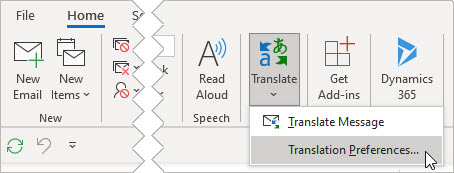
Here you can set your preferred language.
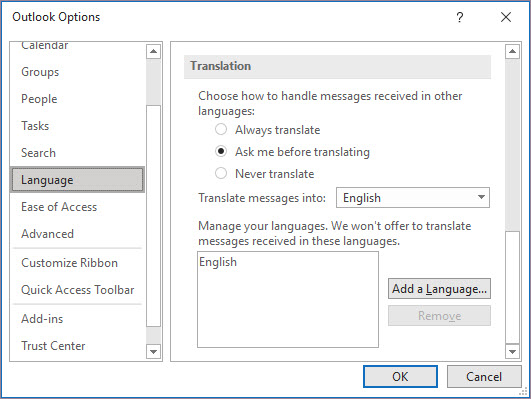
Translate part of an email
To translate just a bit of text from a message, select that text and right-click. Outlook will show you the translation right there in the context menu that appears.
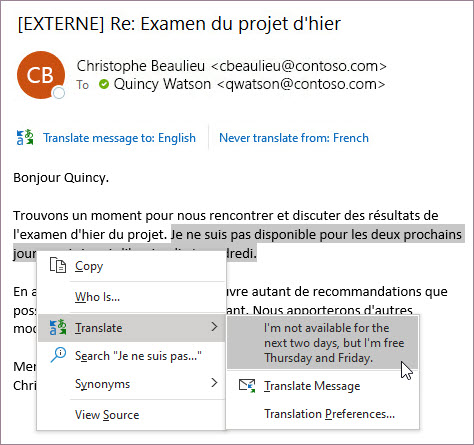
You can also select text and right-click to translate to your preferred language when you’re composing an email. When you click the translated text, you can insert it into the message you’re writing.
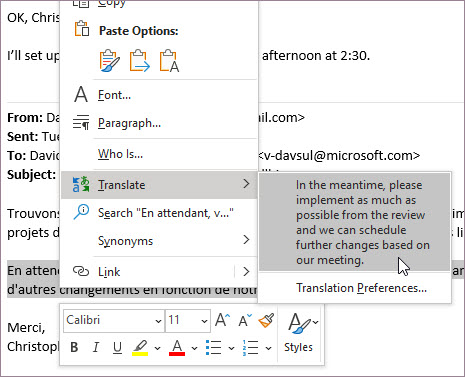
To learn more see Announcing new translation features in Outlook.
Note: Automatic translation and intelligent translation suggestions are only available for Exchange Online mailboxes.
Word for Microsoft 365 makes it easy
In Word for Microsoft 365 when you open a document in a language other than a language you have installed in Word, Word will intelligently offer to translate the document for you. Click the Translate button and a new, machine-translated, copy of the document will be created for you.

Translate words or phrases in Word, Excel, or PowerPoint
-
In your document, spreadsheet or presentation, highlight the cell or text you want to translate.
-
Select Review > Translate.
-
Select your language to see the translation.
-
Select Insert. The translated text will replace the text you highlighted in step 1.
Note: In Excel, there is no Insert button, you’ll have to copy/paste the text you highlighted in step1.
You might see a list of several translations. Expand the translated item to show a usage example in both languages. Choose the one you want and click Copy.
Available in: 

This feature is available to Microsoft 365 subscribers and Office 2019 customers using Version 1710 or higher of Word; or Version 1803 or higher of PowerPoint or Excel. You must also be connected to the internet, and have Office connected experiences enabled to use Translator.
Subscribers get new features and improvements monthly.
Buy or try Microsoft 365
Not sure what version of Office you’re running? See What version of Office am I using?
This feature is not currently available to customers using Microsoft 365 operated by 21Vianet.
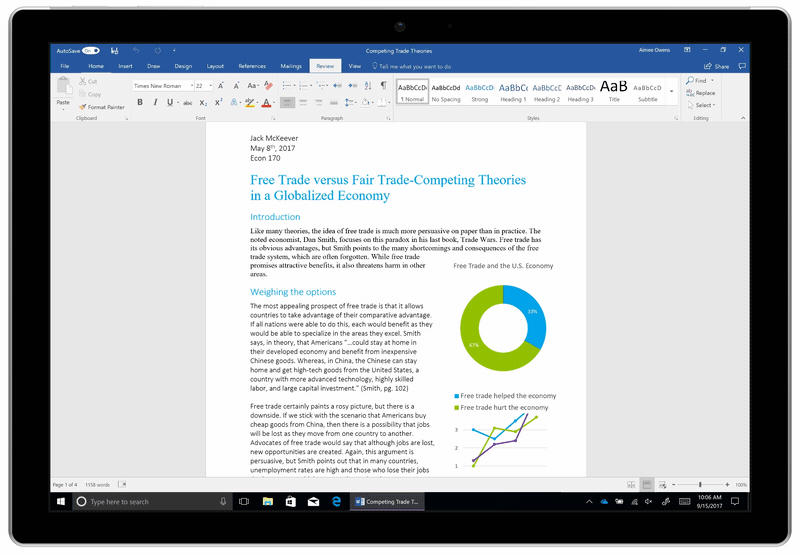
Translate a whole file in Word
-
Select Review > Translate > Translate Document.
-
Select your language to see the translation.
-
Select Translate. A copy of the translated document will be opened in a separate window.
-
Select OK in the original window to close translator.
Available in:
This feature is available to Microsoft 365 subscribers and Office 2019 customers using Version 1710 or higher of Word. You must also be connected to the internet, and have Office connected experiences enabled to use Translator.
Users with Office 2016, but without a subscription, will have the same translation features that are available in Office 2013 and earlier.
Subscribers get new features and improvements monthly.
Not sure what version of Office you’re running? See What version of Office am I using?

Translate words or phrases in OneNote for Windows 10
-
In your notes highlight the text you want to translate.
-
Select View > Translate > Selection.
-
Select your language to see the translation.
-
Select Insert. The translated text will replace the text you highlighted in step 1.
Translate a whole page in OneNote for Windows 10
-
Select View > Translate > Page.
-
Select your language to see the translation.
-
Select Translate. The translated page will be added as a sub-page of the existing page.
-
Select OK in the original window to close translator.
If you later want to change the To language for document translation, or if you need to translate a document to more than one language, you can do so, by selecting Set Document Translation Language…from the Translate menu.

See also
-
Admin considerations for modern translator feature in Office
-
Languages supported by Microsoft Translator
The translation tools available depend on which Office program you’re using:
-
Translate Document/Translate Item: Word, Outlook.
-
Translate Selected Text: Word, Outlook, OneNote, PowerPoint, Publisher, Excel, Visio.
-
Mini Translator: Word, Outlook, PowerPoint, OneNote
You can have an entire Word document or Outlook message translated by a computer («machine translation») and displayed in a web browser. When you choose this kind of translation, the content in your file is sent over the Internet to a service provider.
Note: Machine translation is helpful for conveying the basic subject matter of the content and for confirming whether the content is relevant to you. For high accuracy or sensitive files, human translation is recommended, because machine translation might not preserve the full meaning and tone of the text.
Choose your translation language
-
On the Review tab, in the Language group, click Translate > Choose Translation Language.
-
Under Choose document translation languages click the Translate from and Translate to languages that you want, and then click OK.
Translate the document or message
-
On the Review tab, in the Language group, click Translate.
-
Click Translate Document (Translate Item in Outlook). The From and To languages that you selected are listed.
A browser tab opens with your file in both the original language and the language that you selected for translation.
Note: If this is the first time you have used translation services, you may need to click OK to install the bilingual dictionaries and enable the translation service through the Research pane. You can also see which bilingual dictionaries and machine translation services you have enabled by clicking the Translation options link in the Research pane. See the next section (Translate selected text) to learn how to access the Research pane.
You can use the Research pane to translate a phrase, sentence, or paragraph into several selected language pairs in the following Microsoft Office programs: Excel, OneNote, Outlook, PowerPoint, Publisher, Visio, and Word.
Note: In PowerPoint, only one slide’s text box can be translated at a time.
-
On the Review tab, in the Language group, click Translate > Translate Selected Text to open the Research pane.
Note: In Word, you can right-click anywhere in the document, and then click Translate.
-
In the Research pane, in the All Reference Books list, click Translation.
-
Do one of the following to translate a word or short phrase:
-
Select the words, press ALT, and then click the selection. The results appear in the Research pane under Translation.
-
Type the word or phrase in the Search for box, and then press Enter.
Notes:
-
If this is the first time you have used translation services, click OK to install the bilingual dictionaries and enable the translation service through the Research pane.
-
You can also see which bilingual dictionaries and machine translation services you have enabled by clicking the Translation options link in the Research pane.
-
To change the languages that are used for translation, in the Research pane, under Translation, select the languages that you want to translate from and to. For example, to translate English to French, click English in the From list and French in the To list.
-
To customize which resources are used for translation, click Translation options, and then select the options that you want.
-
-
In Word, Outlook, PowerPoint, and OneNote, the Mini Translator displays the translation of one word as you point at it with your cursor. You can also copy the translated text to the Clipboard, paste it into another document, or play a pronunciation of the translated word.
-
On the Review tab, in the Language group, click Translate > Mini Translator.
-
Point to a word or phrase that you want translated with your mouse. When a faint dialog box appears overlayed in your document, move your mouse over it to see any translations available.
Note: The Mini Translator will continue to appear whenever you move over words. To turn it off, repeat step 1 above.
For more information, see See translations with the Mini Translator.
This feature is only available if you have an Office 365 subscription, or Office 2019 for Mac, and only for Word, Excel, and PowerPoint. For Translator in Outlook see Translator for Outlook for more information.
Translate a whole document
-
Select Review > Translate > Translate Document.
-
Select your language to see the translation.
-
Select Translate. A copy of the translated document will be opened in a separate window.
Available in:
Translate selected text
-
In your document, highlight the text you want to translate.
-
Select Review > Translate > Translate Selection.
-
Select your language to see the translation.
-
Select Insert. The translated text will replace the text you highlighted in step 1.
Note: In Excel, there is no Insert button, you’ll have to copy/paste the text you highlighted in step1.
Available in:
Translate a whole document
Word for the web makes it easy to translate an entire document. When you open a document that is in a language other than your default language, Word for the web will automatically offer to create a machine-translated copy for you.
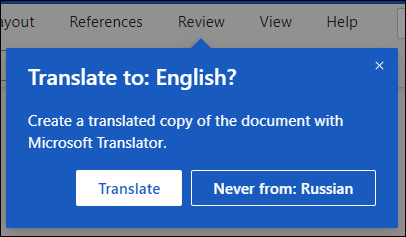
If you’d prefer to initiate the translation manually, you can still do that with these steps:
-
Select Review > Translate > Translate Document.
-
Select your language to see the translation.
-
Select Translate. A copy of the translated document will be opened in a separate window.
Available in:
Translate selected text
-
In your document, highlight the text you want to translate.
-
Select Review > Translate > Translate Selection.
-
Select your language to see the translation.
-
Select Insert. The translated text will replace the text you highlighted in step 1.
Available in:
Translate an email
-
When you receive an email in another language, a prompt will appear at the top of the message asking if you’d like Outlook to translate it into your default language.
-
If you select Translate message, Outlook will replace the message text with translated text.
You can then select Show original message to see the message in the original language or Turn on automatic translation to always translate messages in another language.
-
If you select Never translate, Outlook won’t ask you if you’d like to translate messages in that language in the future.
-
You can change your translation preferences and choose your translation language by going to Settings
> View all Outlook settings > Mail > Message handling.
Available in:
More information
-
Microsoft Translator languages
-
Right-to-left languages
-
Language Accessory Pack for Office
-
Change the language Office uses in its menus and proofing tools
-
Enable or change the keyboard layout language
-
Check spelling and grammar in a different language
Need more help?
Want more options?
Explore subscription benefits, browse training courses, learn how to secure your device, and more.
Communities help you ask and answer questions, give feedback, and hear from experts with rich knowledge.
В данной статье показаны действия, с помощью которых можно перевести документ Word с различных языков на нужный вам язык встроенными средствами программы Microsoft Word.
Если вы работаете с разными языками, но ваши языковые навыки не слишком сильны, то можно использовать быстрый инструмент перевода. В программе Microsoft Word встроен мощный переводчик, поддерживающий множество языков, но для работы этой функции нужно постоянное интернет соединение, так как перевод содержимого документа на другой язык происходит с помощью веб-службы «Переводчик Майкрософт»
Эта инструкция написана с учетом последней версии Word. Для более старых версий Word инструкции и шаги могут незначительно отличаться, но при этом у вас также есть возможность переводить разделы текста, а также целые документы Word аналогичным образом.
Содержание
- Как выбрать язык для перевода
- Как перевести документ
- Как перевести выделенный текст
- Как использовать мини-переводчик
Как выбрать язык для перевода
Чтобы выбрать с какого языка и на какой сделать перевод, откройте документ Word и перейдите на вкладку Рецензирование, в группе «Язык» нажмите кнопку Перевод и в открывшемся выпадающем списке выберите Выбрать язык для перевода…
Затем в окне «Параметры языка перевода», в выпадающих списках выберите необходимые языки для перевода документа (например с английского на русский). При необходимости выберите язык для мини-переводчика. После того как сделаете выбор, нажмите кнопку OK.
Как перевести документ
Чтобы перевести весь документ, откройте документ Word который необходимо перевести и перейдите на вкладку Рецензирование, в группе «Язык» нажмите кнопку Перевод и в открывшемся выпадающем списке выберите Перевести документ.
После этого откроется окно в котором запрашивается разрешение на отправку вашего документа на сторонний сервер, согласитесь с этим нажав кнопку Да.
Каждый раз, когда вы будете делать перевод, Word будет запрашивать разрешение на отправку вашего документа на сторонний сервер, но чтобы это сообщение больше не отображалось, установите флажок опции Больше не показывать
После этого будет переведён весь документ и перевод текста будет открыт на отдельной странице вашего браузера который используется как браузер по умолчанию.
Как перевести выделенный текст
Чтобы перевести выделенный текст, предварительно выделите часть текста, затем на вкладке Рецензирование, в группе «Язык» нажмите кнопку Перевод и в открывшемся выпадающем списке выберите Перевести выделенный текст
После этого в правой части окна появится боковая панель с переводом текста.
Вы можете использовать боковую панель для работы с переводчиком непосредственно из документа Word. Но с большими объёмами текста (больше одного абзаца), работать с ней не совсем удобно.
Как использовать мини-переводчик
Чтобы использовать мини-переводчик, откройте документ Word и перейдите на вкладку Рецензирование, в группе «Язык» нажмите кнопку Перевод и в открывшемся выпадающем списке выберите Мини-переводчик
Если включена функция мини-переводчика, то при наведении курсора на любое слово, будет появляться прозрачная панель с переводом (прозрачной она сделана для того, чтобы не отвлекать от работы, когда перевод не требуется), при наведении указателя мыши на панель, она перестанет быть прозрачной.
Используя рассмотренные выше действия, можно перевести документ Word с различных языков на нужный вам язык с помощью встроенного переводчика.
В процессе работы с документами Word, пользователю может понадобится переводчик Ворд для перевода отдельных слов, фраз или предложений, а также всего файла на другой язык. Согласитесь, что это полезная функция, о которой не все знают.
При использовании в тексте документа иностранных слов, или при наличии документа на иностранном языке возникает необходимость в переводе содержимого на язык пользователя программы. В других случаях, наоборот, требуется перевести весь текст или фрагмент текста на иностранный язык.
Содержание:
- Перевод текста Word: особенности использования встроенного средства
- Переводчик Word с английского на русский язык — перевод отдельных слов и предложений
- Перевод текста документа Ворд — перевод содержимого всего документа
- Настройки Переводчика Майкрософт в Word
- Переводчик Майкрософт в Word онлайн
- Выводы статьи
Не секрет, что далеко не все в совершенстве владеют иностранными языками, поэтому пользователи используют для получения перевода программное обеспечение в приложениях или на онлайн сервисах в интернете. Решить проблему поможет переводчик Word, использующий в своей работе облачную службу Microsoft Translator.
В программе Word, а также в других приложениях из состава офисного пакета Microsoft Office, имеется встроенная функция переводчика текста.
Перевод текста Word: особенности использования встроенного средства
Переводчик текста Ворд использует облачную службу Word Translator, работающую на основе Microsoft Translator.
Переводчик Майкрософт поддерживает функцию перевода с более 60 языков. С помощью искусственного интеллекта (ИИ) и технологии нейронных сетей обеспечивается более высокое качество перевода, чем при обычном машинном переводе на основе статистических данных.
В настоящее время, в Microsoft Translator нейросети, использующие нейро-машинный перевод (NMT), доступны для 21 языка: английского, арабского, китайского, японского, французского, испанского, немецкого, итальянского, португальского, русского, хинди, турецкого, корейского, польского, болгарского, датского, норвежского, румынского, чешского, нидерландского и шведского. Список поддерживаемых языков постоянно увеличивается.
Нейро-машинный перевод позволяет увеличить качество и повысить скорость перевода, по сравнению с обычным статистическим машинным переводом (SMT).
Встроенный переводчик в Word использует облачную службу перевода Microsoft Translator, поэтому для его работы необходимо постоянное интернет-соединение.
Переводчик Майкрософт можно использовать в двух вариантах:
- Встроенное средство в программе MS Word.
- Онлайн переводчик Word из браузера.
В первом случае, на компьютере должен быть установлен текстовый редактор — программа Microsoft Word. Во втором случае, можно обойтись без установки платного приложения на ПК, используя бесплатный вариант — Word Online, доступный пользователям из веб-интерфейса некоторых облачных хранилищ в браузере.
В программе Word из состава офисного пакета Microsoft Office, имеется встроенная функция переводчика текста.
В основном, пользователями используются два типа функций перевода:
- Перевод отдельных слов, фраз, словосочетаний, предложений и абзацев в тексте документа Word.
- Перевод всего документа Word.
В этой статье вы найдете инструкции о том, как перевести в Word отдельные слова, фразы или предложения с помощью встроенного средства, а также использование переводчика документа Ворд для перевода всего содержимого данного файла.
Отдельно в этом руководстве рассмотрим пример работы функции перевода текста документа в бесплатном онлайн сервисе Word Online.
В этом обзоре использован интерфейс последней версии Word, в предыдущих версиях приложения выполняются похожие действия с незначительными отличиями, касающимися внешнего вида.
Переводчик Word с английского на русский язык — перевод отдельных слов и предложений
Довольно часто пользователям нужно выполнить перевод теста Word с английского на русский или для других языковых пар. Сначала рассмотрим способ перевода отдельной части документа.
Чтобы использовать переводчик с английского Ворд (или на другие языки), воспользуйтесь одним из удобных способов.
1 способ:
- Откройте документ Word.
- Войдите в меню «Рецензирование».
- Выделите текст, который необходимо перевести: отдельное слово, фразу, предложение или абзац.
- В группе «Язык» нажмите на кнопку «Перевод».
- В выпадающем меню нужно выбрать «Перевод выделенного фрагмента».
- В правой части окна документа Word откроется область «Переводчик».
- Во вкладке «Выделенный фрагмент», в поле «Исходный язык» вставлен текст на языке оригинала. По умолчанию язык автоматически определен, в данном случае, это английский язык.
- В поле «Язык перевода», в нашем случае, русский, вставлен перевод фрагмента текста. Если это одно слово, то ниже отображены возможные варианты перевода.
- Нажмите на кнопку «Вставить», чтобы заменить в документе оригинальный фрагмент текста на переведенный.
2 способ:
- Выделите нужный фрагмент текста в документе Word.
- Щелкните правой кнопкой мыши.
- В контекстном меню выберите пункт «Перевести».
- На правой боковой панели появятся поля с переводом выделенного текста.
Перевод текста документа Ворд — перевод содержимого всего документа
Переводчик с английского Word поможет перевести содержимое всего документа, а не только отдельных фрагментов текста.
1 способ:
- Откройте документ в программе Microsoft Word.
- В открытом документе появится окно с предложением «Перевести этот документ?».
Этим способом создается переведенная копия документа с помощью Переводчика Майкрософт.
- Нажмите на кнопку «Перевести».
- На боковой панели «Переводчик», во вкладке «Документ» нажмите на кнопку «Перевести».
- На компьютере откроется отдельное окно программы с переводом документа Word.
В нашем случае, переводчик с английского на русский Ворд справился с поставленной задачей.
В открывшемся окне с копией перевода можно исправить неточности перевода, если что-то переведено не совсем корректно. В любом случае, есть и другие способы решить проблему с текстами на иностранном языке, о которых можно прочитать на этом сайте.
2 способ:
- В окне открытого документа Word войдите в меню «Рецензирование».
- Нажмите на кнопку «Перевод», которая находится в группе «Язык».
- В открывшемся контекстном меню выберите пункт «Перевести документ».
- В области «Переводчик», во вкладке «Документ» нажмите на кнопку «Перевести».
- На ПК откроется переведенная копия файла Word.
3 способ:
- В открытом окне документа Word щелкните по тексту правой кнопкой мыши.
- В контекстном меню нажмите на пункт «Перевести».
- В боковом меню «Переводчик» нажмите на кнопку «Перевести».
- Переведенный документ откроется в отдельном окне приложения.
Настройки Переводчика Майкрософт в Word
Пользователь может изменить некоторые параметры перевода. Для этого ему потребуется выполнить следующее:
- В боковой области «Переводчик» нажмите на кнопку с изображением шестеренки.
- В окне «Настройки» доступно два пункта:
- Предлагать для перевода содержимое на языках, которые я не понимаю.
- Никогда не предлагать для перевода документы и содержимое на этих языках.
Здесь можно добавить другие языки, чтобы исключить предложения о переводе с содержимым на этих языках.
Переводчик Майкрософт в Word онлайн
Чтобы перевести фрагмент текста документ Word, пользователь может воспользоваться помощью онлайн сервиса. Бесплатный сервис Word онлайн встроен в некоторые облачные хранилища, поэтому пользователи могут работать с документами, сохраненными в форматах DOC или DOCX, без использования программ, входящих в Microsoft Office.
Данный способ удобен тем, что доступ к документу можно получить на любом устройстве с любого места, понадобится лишь Интернет.
Выполните следующие действия:
- Используя браузер войдите в облачное хранилище OneDrive, Яндекс Диск или Mail.Ru.
- Загрузите нужный документ Word в облачное хранилище.
- Откройте документ в окне онлайн сервиса.
- Во вкладке «Рецензирование» нажмите на кнопку «Перевод» или на стрелку около этой кнопки, чтобы выбрать параметры перевода:
- Перевод выделенного фрагмента.
- Перевод документа.
- Выделите участок текста, чтобы получить его перевод.
- В боковом меню отобразится перевод выделенного фрагмента.
Выводы статьи
При работе в офисном редакторе, в тексте документа встречаются иностранные слова или выражения, поэтому пользователю необходим переводчик на русский Ворд. С помощью переводчика можно перевести непонятные слова, написанные на другом языке.
В программу Word встроен переводчик, использующий сервис Microsoft Translator. Благодаря этому, пользователи смогут переводить фрагменты текста или полностью весь документ Word в окне приложения. В других случаях используйте похожий метод перевода с помощью сервиса Word онлайн.
Похожие публикации:
- Как убрать пустую страницу в Ворде — 6 способов
- Как выделить текст в Word: разные способы
- Как убрать выделение текста в Word — 6 способов
- Редактирование PDF онлайн — 5 сервисов
- Как перевернуть страницу в Ворде
Here’s how to translate text from one language to another in Outlook, Word, and Excel — and how to transform spoken words into real-time captions in another language with PowerPoint.
cybrain / Shutterstock 
- Translate in Microsoft Outlook on the desktop
- Translate in Microsoft Outlook on the web
- Translate in Microsoft Word
- Translate in Microsoft Excel
- Translate in Microsoft PowerPoint
Show More
I once worked for an international company that was headquartered in Switzerland and have always been fascinated by languages and dialects. I enjoyed the frequent exchanges with Swiss colleagues who knew four or five different languages. Their emails gave me a tantalizing taste of another culture. I’m also half Italian and exchange frequent emails with Italian relatives.
When the person I’m emailing is more comfortable writing and reading in their native tongue than in English, I don’t let my own inability to write in that language slow me down. I simply use Microsoft Translator to translate my emails for them and their emails for me. Not only does it expand my view of the world, but it also gives me the chance to sharpen my Italian as I watch how Translator turns Italian into English and English into Italian.
If you want to translate text in Outlook emails, Word documents, Excel spreadsheets, or PowerPoint presentations, it’s easy to do. Maybe you work for an international company, like I did, or perhaps you communicate with colleagues or customers who are more comfortable writing in their native language. None of this is a problem for Office, which offers translation courtesy of an AI-powered Translator service that can translate a selection of text or an entire document, file, or message between many different languages.
The Translator service is accessible across multiple Microsoft products and technologies on the consumer and enterprise sides. Translator is integrated into Bing, Microsoft Office, SharePoint, Microsoft Edge, Skype Translator, and Visual Studio. Microsoft Translator is also available as an app for iOS/iPadOS, Apple Watch, Android OS, and Android Wear.
Translator supports more than 100 languages, including more common languages, such as English, French, Italian, Spanish, German, Chinese, Japanese, and Arabic, and some less common languages, including Fijian, Haitian Creole, Icelandic, Kurdish, Maltese, Serbian, and Ukrainian.
The accuracy of Microsoft Translator is evaluated using a BLEU (Bilingual Evaluation Understudy) score. This score measures the differences between a machine-based translation and a human translation of the same source text. One report from 2018 measuring Chinese to English translation gave Microsoft Translate a grade of 69 out of 100, which is a high score compared to human translation. This will likely improve with time, too, at least according to a Microsoft Translator blog post from November 2021 that explains how the company is working to advance its machine translation technology.
Now, here’s how to use the translator in the different Office applications.
Translate in Microsoft Outlook on the desktop
If you’ve purchased Outlook 2019 or later for Windows as a standalone app or as part of Microsoft Office or Microsoft 365, the translation functionality is built in. To set it up, click the File menu and select Options. In the Outlook Options window, select Language.
The window now displays your default display language for Office. Scroll down to the Translation section. Here, you can decide how to handle messages received in other languages, opting to always translate them, get asked before translating, or never translate. Next, select the target language if it’s not your default language. Then click the Add a Language button and select any languages for which you don’t want to see a translation.
You can tweak the translator settings in Outlook to better manage the feature. (Click image to enlarge it.)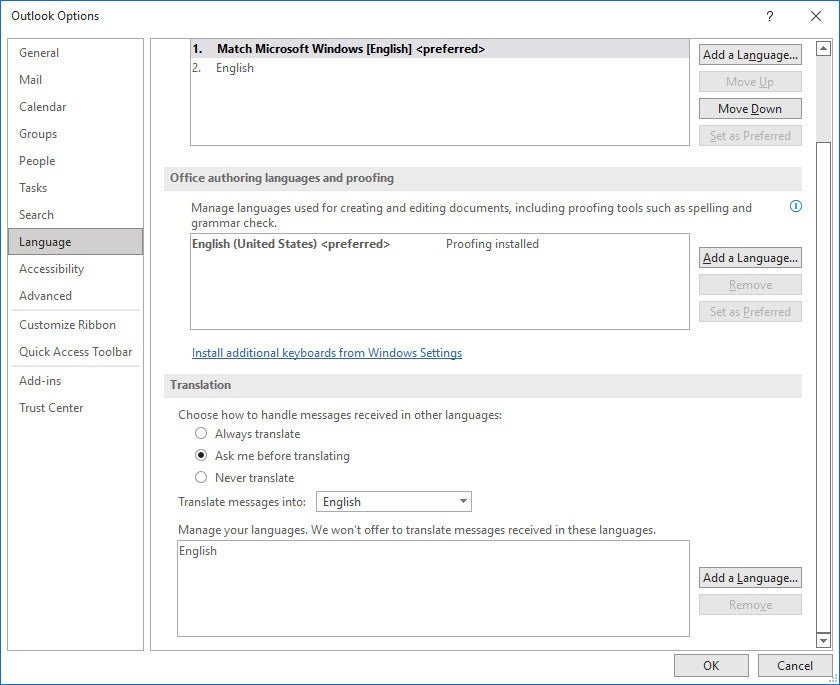
Close the Options window and return to the main Outlook screen. Open an email you want translated into your native language. Depending on the options you chose, the email will automatically be translated or give you the ability to have it translated. Either way, you should see a link in the message to translate the message to your language. If not, click the Translate button on the Ribbon and select the Translate Message command.
Outlook should offer to translate a message automatically. If not, you can manually trigger the translation. (Click image to enlarge it.)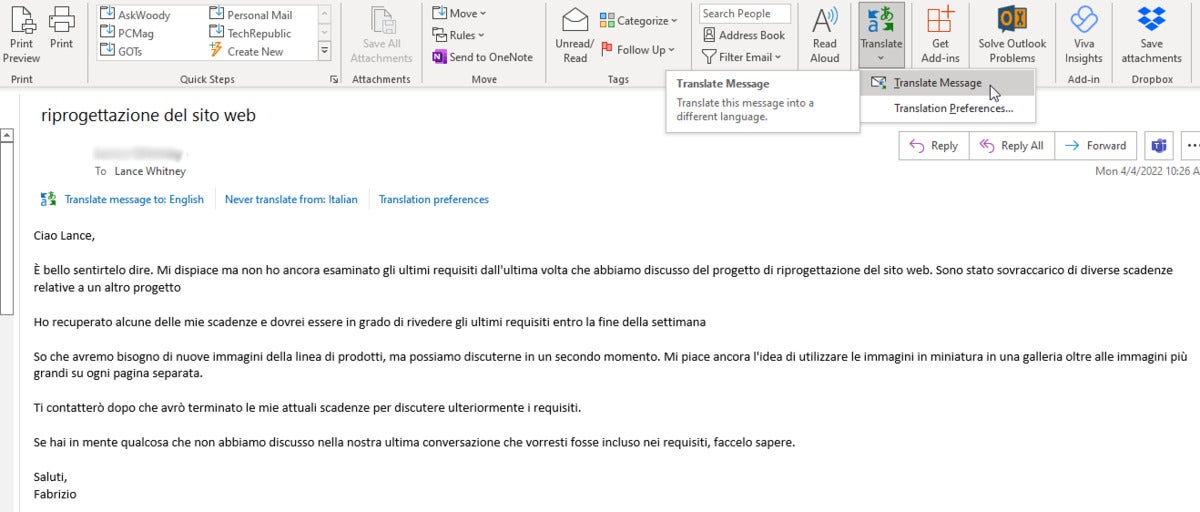
Run the translate command, and the entire message appears in your native language. You can then switch back and forth between the translation and the original text and turn on automatic translation if it’s not already enabled.
You can easily jump between the translated message and the original text. (Click image to enlarge it.)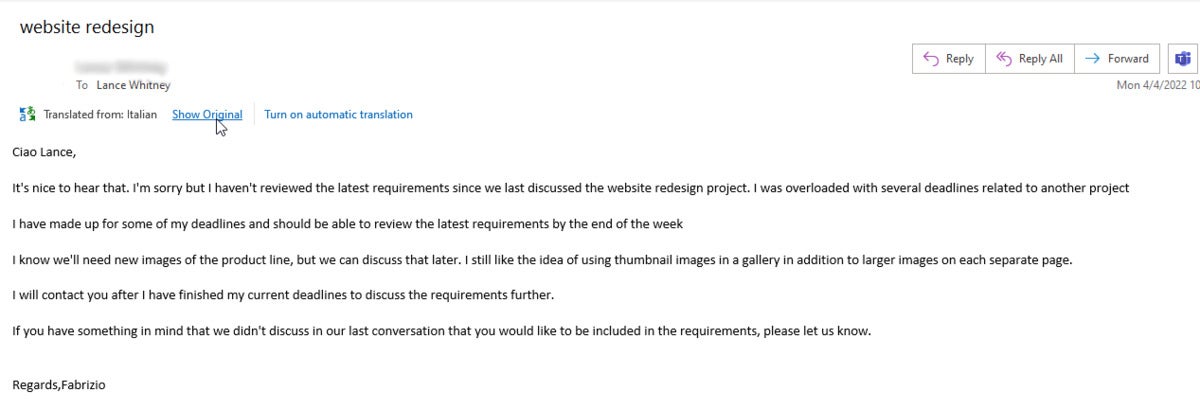
What if you want to take the reverse trip and translate an email you’re composing from your own native language to a different language? Unfortunately, Microsoft currently offers no reliable or workable way to do this in Outlook. The easiest workaround is to translate the text in Word, then copy and paste it into your message in Outlook.
Translate in Microsoft Outlook on the web
The translation service is also accessible for Outlook on the web. To set it up here, sign into Outlook with your Microsoft or business account. Click the Settings icon at the top right. In the Settings pane, click the link for View all Outlook settings. In the Settings window that pops up, select Mail and then Message handling. Scroll down to the Translation section and you’ll find the same settings as in the desktop version of Outlook.
Outlook on the web offers the same translation settings as the desktop version. (Click image to enlarge it.)
When you receive a message in a different language, the Translate feature will offer to translate it for you. Click the link to translate it. You can then switch back and forth between the original text and the translation.
As with the desktop flavor of Outlook, the web version presently offers no workable method for translating a new email from your own native language to a different language. Again, translating the text in Word is your best bet.
Translate in Microsoft Word
The translation feature in Microsoft Word works much the same way in the desktop and online versions.
Open a document that you want to translate, either in full or in part. Select the Review tab on the Ribbon. To customize the feature before using it, click the Translate button and select Translator Preferences. In the Translator pane that appears on the right, confirm that the switch is set to Yes for “Offer to translate content that isn’t in a language I read.” You can also add any languages that you don’t want translated.
If you only want certain text translated, select the text. Click the Translate button in the Ribbon and choose Translate Selection. In the Translator pane on the right, make sure the correct source language is detected. If it’s not correct, click the down arrow for the target language and change it. Hover your mouse over each word in the translation, and the feature will show you the translation just for that word. To add the translation to your current document, click the blue Insert button at the far right.
Select the text you want translated and then run the Translate command. (Click image to enlarge it.)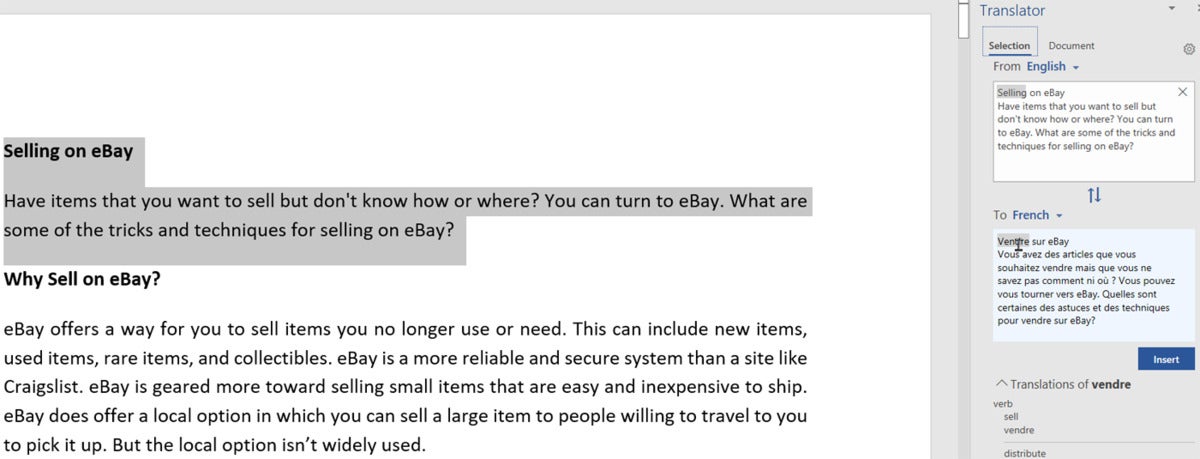
Similarly, to translate the entire document, click the Translate icon in the Ribbon and select Translate Document. In the Translator pane, make sure the Document tab is selected. Confirm that the target language is correct. Click the blue Translate button at the far right. A new document is created and pops up with the complete translation.
In Word, you can opt to translate the entire document as well as selected text. (Click image to enlarge it.)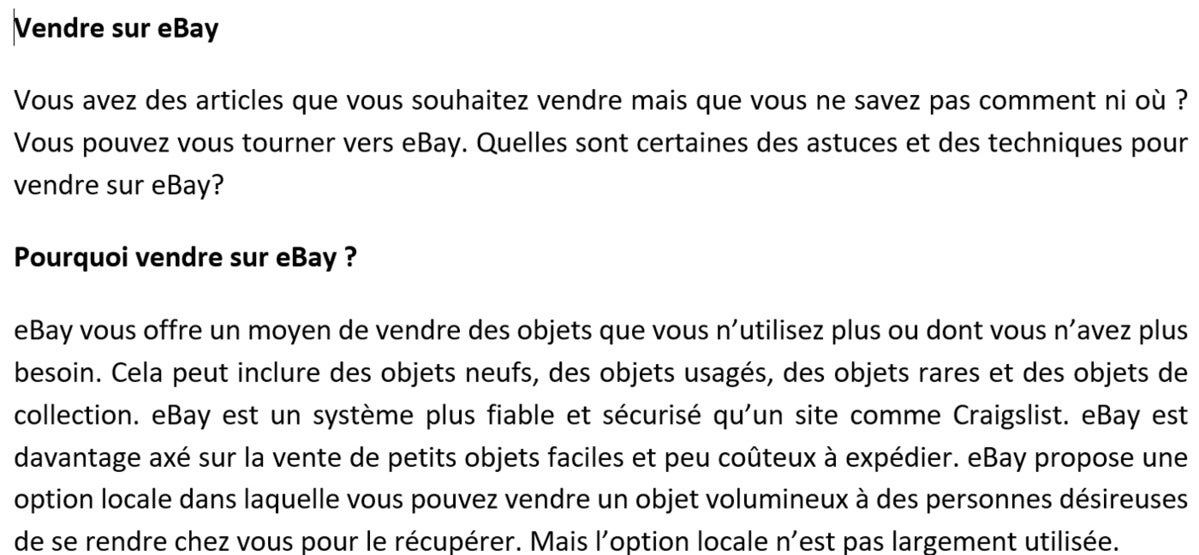
Translating from your own language to another works much the same way. Select the text you want to translate (or don’t make a selection if you want to translate the entire document), then click the Translate icon in the Ribbon’s Review tab and select either Translate Selection or Translate Document. In the Translate pane, set the target language in the To: field. Any selected text is automatically translated and appears in the pane. To translate a document, click the blue Translate button.
Translate in Microsoft Excel
The translation for Excel works only in the desktop version of the program. Select a cell or multiple cells that contain text you want translated. Click the Review menu and select Translate. In the Translate pane, make sure the source and destination languages are correct. You can then hover over each word to see its individual translation.
In the desktop version of Excel, you can select one or more cells to translate text. (Click image to enlarge it.)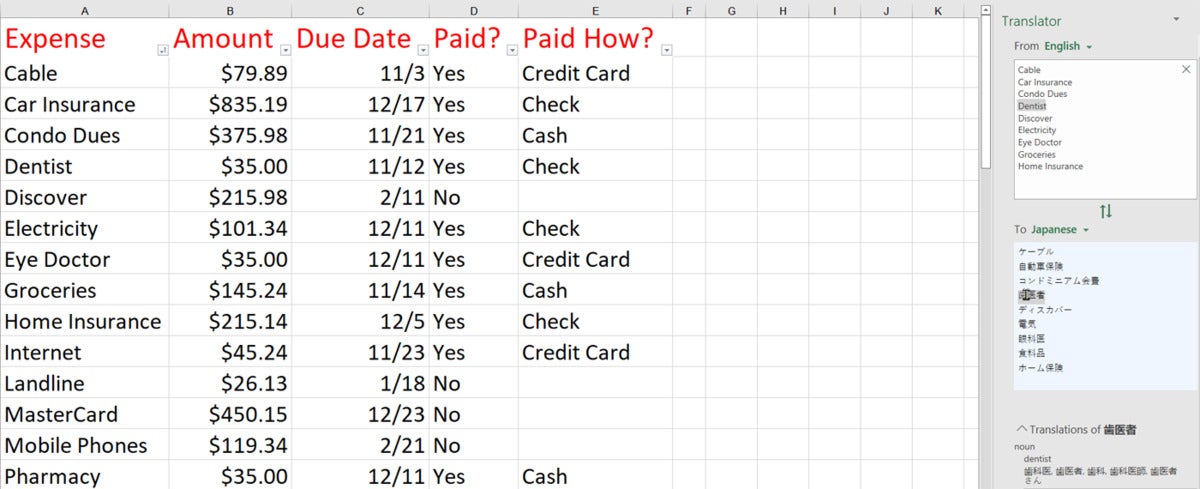
To insert the translated text into a cell in your spreadsheet, select and copy the translation in the pane. Click the target cell and then paste the text.
Translate in Microsoft PowerPoint
As with Excel, translation for PowerPoint is available only in the desktop client. PowerPoint can translate selected text (not a whole presentation); it works just like translating selected cells in Excel.
PowerPoint also offers a handy feature that can translate your presentation as you speak it, which is great if you have an audience that is more comfortable in another language. The translations appear as subtitles as you deliver the presentation.
To get started, click the Slide Show menu and check the box for Always use subtitles. Then select Subtitle settings. In the web version of PowerPoint, click the Slide Show menu and select the down arrow next to Always use subtitles. Select or confirm the spoken language. Then select the subtitle language. Go back to the subtitle settings menu to choose where you want the subtitles to appear — overlaid on the bottom, overlaid on the top, above the slide, or below the slide.
In PowerPoint, you can choose a language for translated subtitles and decide where the subtitles should appear. (Click image to enlarge it.)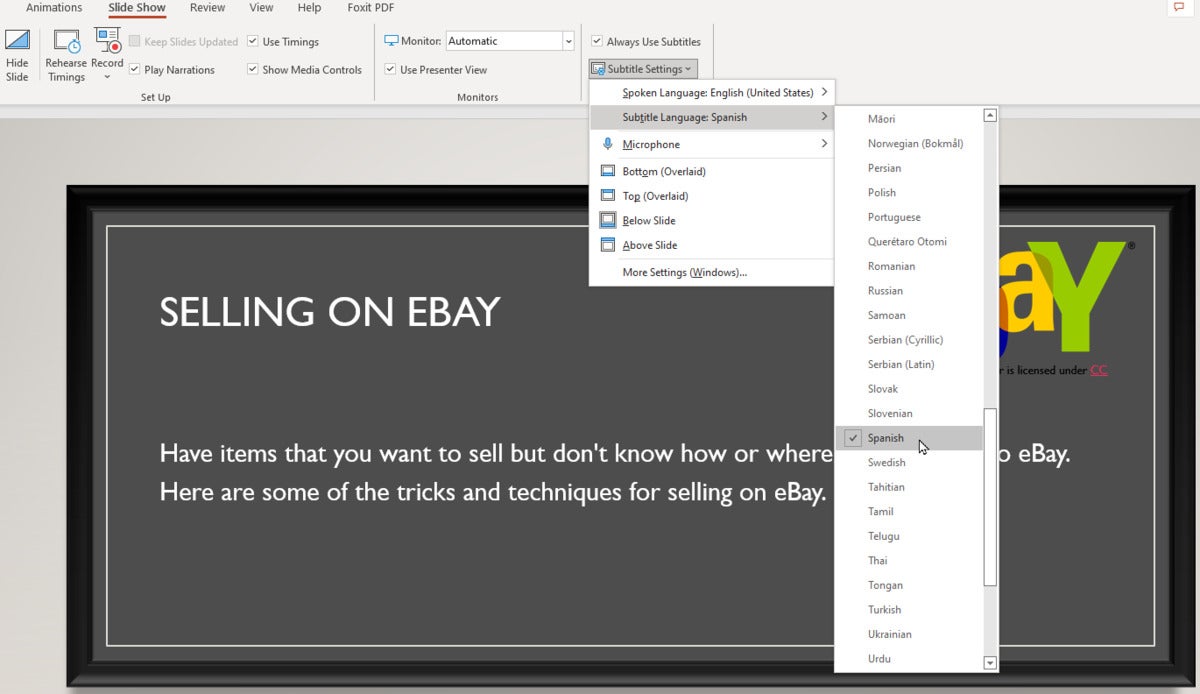
When you display the presentation as a slideshow, speak the words from each slide or from your own commentary. Subtitles for your spoken words will appear in the language you chose.
The subtitles appear in the translated language as you speak. (Click image to enlarge it.)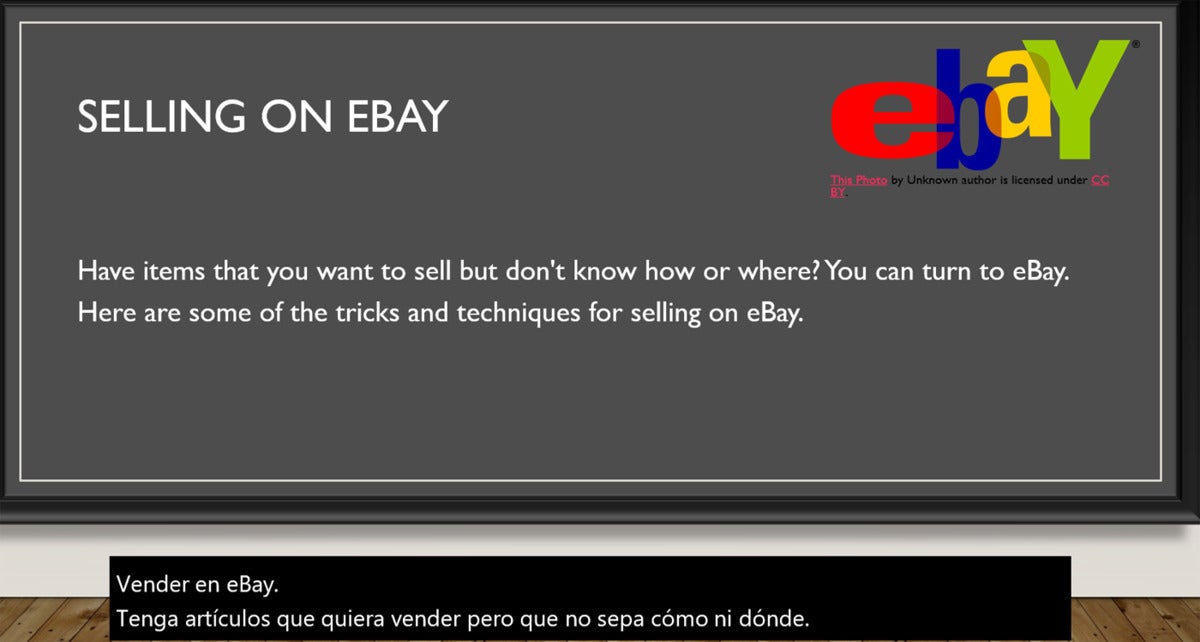
Lance Whitney is a technology journalist and trainer with a background in IT. He’s written for a host of sites and publications, including CNET, TechNet Magazine, TechRepublic, PCMag, Macworld, AskWoody, Time, and AARP Magazine, and is the author of the books «Windows 8: Five Minutes at a Time» and «Teach Yourself Visually LinkedIn.»
Copyright © 2022 IDG Communications, Inc.
Do you want to write a letter or an article in a foreign language? Microsoft Office offers a Translate feature available in Microsoft Word, Microsoft Excel, PowerPoint, and One Note. The Translate feature converts content into a different language using the Microsoft Translator online service; in Microsoft Word, it includes two options Translate Selection and Translate Document.
Although the Translate feature is offered in Microsoft Office programs such as Microsoft Word, Microsoft Excel, PowerPoint, and One Note, Translate Selection and Translate Document are only found in Microsoft Word. The Translate Selection’s purpose is to translate the selection with Microsoft Translator, and the Translate Document’s purpose is to create a translated copy of your Document with Microsoft Translator.
In this tutorial, we will explain:
- How to use the option Translate Selection.
- How to use the option Translate Document.
Let us discuss this in more detail.
1] How to use Translate Selection option in Office
Highlight the text.
On the Review tab of any Office programs, click the Translate button in the language group.
In Microsoft Word or OneNote, when the Translate button is clicked, you will see a drop-down list.
In the drop-down, click Translate Selection.
A Translator Pane will pop up on the right of the window.
In the Translator Pane, there are two options From and To
From is the language you want to translate.
To is the language you want the selected text to be translated to.
Choose a language from the To section by clicking the drop-down arrow and selecting a language.
Then click Insert.
The text is translated.
In the Microsoft Excel and PowerPoint programs, when the Translate button is selected.
A Translator Pane will pop up on the right of the window.
For PowerPoint, like Word, you have to highlight the text first before selecting a language and clicking Insert.
In Excel, you don’t have to highlight the text.
2] How to use Translate Document option in Office
On the Review tab of any Office programs, click the Translate button in the language group.
In Microsoft Word or OneNote, when the Translate button is clicked, you will see a drop-down list.
In the drop-down, click Translate Document.
A Translator Pane will pop up on the right of the window.
Inside the Translator Pane in the To section, click the drop-down arrow and choose a language.
If you want to keep that particular language, check the checkbox for Always translate to this language.
Then click Translate.
A copy of the document is open with the translated text.
In OneNote, PowerPoint, and Excel, this option is not available.
In OneNote, instead of a Translate Document option, there is a Mini Translator option.
Highlight the text in the notebook.
Click the Translate button.
In the drop-down list select the Mini Translator option.
Once the Mini Translator option is selected, a Translation Language Options dialog box will open.
Inside the dialog box, choose a language from the Translate to list box.
Then click OK.
Hover the cursor over the text, and you see a small window containing the foreign language.
Once the language is chosen, it will remain as the language selected in the Mini Translator.
To set it back to English, highlight the text.
Click the Translate button and select Choose Translation Language.
A Translation Language Options dialog box will open.
Inside the dialog box, choose a language from the Translate to list box.
Then click OK.
We hope this tutorial helps you understand how to translate text into a different language in Microsoft Office.


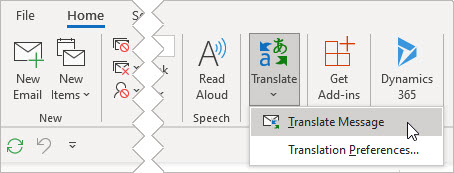



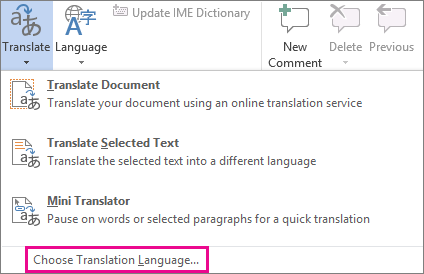
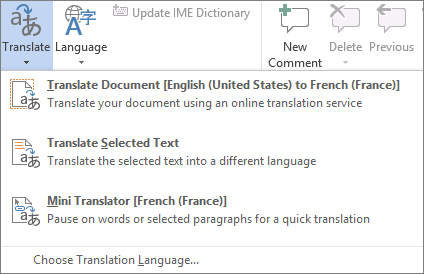
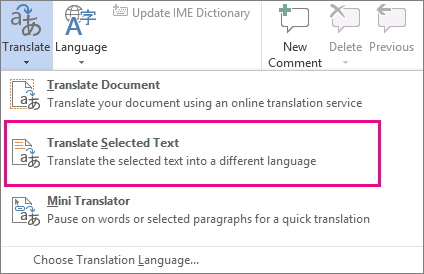

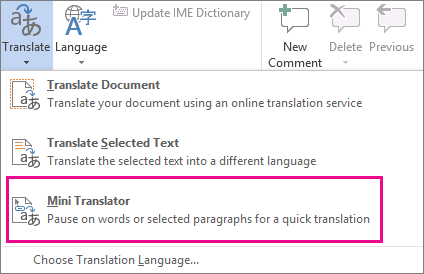
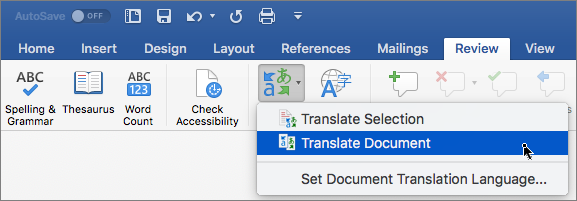
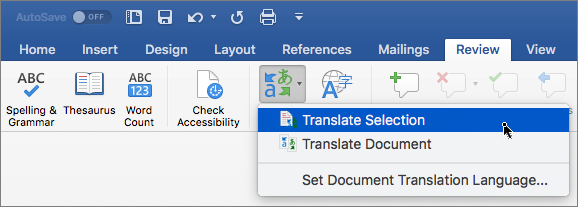

 > View all Outlook settings > Mail > Message handling.
> View all Outlook settings > Mail > Message handling.



















